Serbian cuisine is heavy on meat, dairy, and grains, a product of the nation’s geography and history. Serbia’s mountainous south lends itself to pastoralism and the earliest Serbs were mostly herdsmen. The Ottomans, who dominated Serbia from the 14th-19th centuries, were more interested in Serbia’s fertile river valleys, concentrated in the north. Serbs and their culture were pushed upland and became even more dependent on the milk, meat, and marketable products from sheep, cattle, and goats. They also incorporated considerable pork to their diets, which they discovered the Muslim Ottomans would not tax or requisition.
Serbia’s south is the homeland for many of its most distinctive dishes. At the same time, Serbia’s cuisine shows heavy influence from Slavic, Turkish, and Austro-Hungarian influences. It also shares many dishes and techniques with other Balkan cultures, especially Bosnian, Croatian, and Macedonian, with which it also shares a mutually intelligible language. The Serbs are skilled cheese makers and baked goods such as pies and/or various breads appear with almost every meal. The flavor palate is heavily dominated by the richness of meat and dairy fats as well as bay leaves, introduced from Mediterranean trade routes, and especially paprika. Peppers were introduced to Serbia in the 1600s and quickly became a staple of the national cuisine. Paprika, made from peppers, became a major export product for Serbia.
Serbian cuisine is heavily integrated with hospitality and holiday traditions. It is also acutely expressed in modern kafana traditions. Kafanas, adapted from Turkish coffee shops in the late Ottoman Empire, came to heavily feature ethnic Serbian drinks, food, and music. They were hotbeds for Serbian independence and remain centers for Serbian intellectual and youth culture.

Ajvar: (Condiment) This roasted red pepper and eggplant relish is slow-cooked over a wood fire to achieve a rich, slightly smoky flavor. It’s often served as a spread for bread or used as a condiment for grilled meats. The name comes from the Serbian word for a red bell pepper, “ajvarka.”
Bajadera: (Dessert) A layered chocolate and hazelnut dessert made with ground nuts, sugar, and butter, topped with a smooth chocolate glaze. A popular sweet treat at celebrations.
Bay Leaves: (Seasoning) Introduced to Balkan cooking long ago through Mediterranean trade routes, bay leaves are used to season almost any soup or other savory dish in Serbia from pasulj to sarma to fermented cabbage. It lends a subtle herbal and slightly floral aroma.
Burek: (Breads) A flaky, layered pastry filled with minced meat, cheese, or spinach. A popular breakfast or street food across the Balkans.
Česnica: (Breads) A traditional Serbian yeasted Christmas bread, symbolizing prosperity and unity. It is often baked with a hidden coin, a piece of the Yule log (badnjak), and a corn kernel (kukuruzno zrno), each carrying symbolic meaning; wealth, divine protection, and fertility. The bread is broken by hand and shared among family members as part of the Christmas feast.
Ćevapi: (Main Dish) Small, grilled minced meat sausages typically made from a mixture of beef, lamb, and pork. Typically cooked over charcoal or wood flame for extra flavor. Usually served with flatbread, chopped onions, and kajmak or ajvar as condiments.

Coffee: (Beverage) Serbs drink strong, dark, unfiltered coffee that is most often referred to as “domestic coffee” (domaća kafa), which is similar to Turkish coffee. It is brewed in a little long-handled copper pot called a “džezva” and drunk from a tiny, handle-less cup called a fildžan. Offering a guest a cup of domaća kafa is a sign of hospitality and meeting friends and a kafana (traditional café) for a cup of coffee is a common social ritual. While espresso-based drinks have become increasingly popular, especially in urban areas, traditional Serbian coffee remains a deeply ingrained part of daily life.
Cherries: (Ingredient) Cherries, particularly sour cherries known as višnje in Serbian, feature prominently in Serbian cuisine. They are widely grown across the country, but particularly in central Serbia, where the climate is ideal for cherry orchards. Cherries are used in making a version of slatko as well as višnjevača, a cherry liqueur, and štrudla sa višnjama, a cherry-filled strudel.
Čvarci: (Appetizer) These Serbian cracklings are essentially deep-fried bacon, cooked in a mixture of lard and milk. The milk regulates the temperature, allowing a slightly slower cooking time, and adds a layer of caramelization to the end product. Once considered “peasant food,” these are now considered national delicacies and often served in restaurants as snacks or appetizers, especially accompanying beer, wine, or spirits.

Duvan Čvarci: (Appetizer) This specialty version of čvarci originated in the Western Serbian town of Valjevo, which now has a yearly festival to celebrate the delicacy. Bacon is slowly fried, with constant stirring, until all meat fibers are separated from each other and the fat. They are then strained out and salted. Eaten much like regular čvarci, but they are particularly prized for their airy, crispy quality and the amount of extra work it takes to produce them.
Đuveč: (Main Dish) A hearty mixed vegetable dish, traditionally slow-cooked in an earthenware pot and often compared to ratatouille. Very often enjoyed in other Balkan countries as a vegetarian dish or side dish, the Serbs often use it a base for cooking casserole-like meat dishes with chicken, fish, sausage, or meat balls.
Đuvečare: (Food Preparation) An earthenware pot used to cook many traditional Serbian dishes. The Serbian village of Zlakusa is famous for making them using the same technique for over 400 years. They can range from small, personal size pots to pots large enough to cook banquet dishes in.
Garlic: (Seasoning) Garlic is native to Serbia and features strongly in many dishes such as ćevapi, sarma, and prebranac. Its pungent, slightly spicy aroma is a hallmark of Serbian grilled and slow-cooked foods.
Gibanica: (Breads) Filo dough layers are filled with mixture of beaten eggs, cheese (feta, sometimes with cottage or a hard white cheese), baking powder, and sometimes kajmak, and then baked to a golden brown.
Green Tomatoes: (Ingredient) Crunchy and tart, green tomatoes feature in some Serbian salads, either pickled or fresh.
Honey: (Ingredient) Serbia has a tradition of beekeeping dating back to at least medieval times. Honey has been a natural sweetener of choice and is often used in slatko fruit preserves and as a fermenting agent in Serbian tipples.
Jagnjetina ispod sača: (Main Dish) Lamb slow-roasted under a metal bell (sač), giving it a tender, fall-off-the-bone texture and a deep, smoky flavor. Often cooked together with carrots, onions, and potatoes.
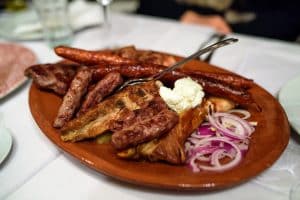
Kajmak: (Dairy product) A rich, creamy dairy spread similar to clotted cream, often served with bread or grilled meats.
Karadjordjeva šnicla: (Main Dish) A breaded and fried rolled pork or veal schnitzel, filled with kajmak and served with tartar sauce.
Kavurma: (Main Dish) A preserved meat dish made by slow-cooking small pieces of lamb or beef in its own fat and storing it jarred together with the fat. This gives it a long shelf life and it is especially popular especially in winter, served warm or cold, often spread on bread. An older, more rural usage (especially in southern Serbia) refers to kavurma as an intestine or organ-meat dish, cooked in its own fat and stored for winter. This is rarer today, however.
Kiflice: (Breads) Small, crescent-shaped bread rolls, often stuffed with jam, cheese, or walnuts, and served as a sweet or savory treat.
Kiseli kupus: (Ingredient; Side Dish) Fermented cabbage, a key ingredient in many Serbian dishes, including sarma and various stews. Sometimes served as a side to meat dishes.
Knedle sa šljivama: (Dessert) Plum dumplings made from a potato-based dough, boiled and coated with sweet breadcrumbs.
Kobasica: (Main Dish) “Kobasica” is literally just the Serbian word for “sausage.” This food category has long played a strong role in Serbian diets and cuisine as way to preserve meats through the winter. Traditionally, Serbian sausages are flavored with garlic, salt, paprika, and often other spices, and smoked. There are also many regional varieties, which vary based on meat type, grind, if the sausage is dried or not, and especially on the specific spice mixture used.
Kompot: (Beverage) A traditional non-alcoholic fruit drink made by simmering fruits with sugar and spices. This is popular across Slavic cultures and across the former USSR.
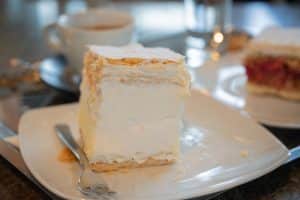
Krempita: (Dessert) Once highly associated with the Austro-Hungarian monarchy, this custard-filled puff pastry with a light, airy texture, is a popular offering in Serbian patisseries.
Kulen: (Appetizer) A spicy, dry-cured pork sausage seasoned with paprika and garlic, typically enjoyed as an appetizer.
Kupus salata: (Side dish) A simple fresh cabbage salad dressed with oil, vinegar, and salt, often served as a refreshing side to heavier meat dishes.
Lepinja: (Bread) This soft, round, yeasted flatbread has a slightly crispy crust and an airy interior. Commonly used as a base for grilled meats like ćevapi and pljeskavica. Its chewy texture and mild flavor make it perfect for soaking up condiments and meat juices.
Leskovački roštilj: (Food Preparation) Leskovac is a city in southern Serbia. It once sent its famous meats daily throughout Serbia via express trains. The meat is chopped, chilled for several hours, then ground and kneaded with spices, baking soda, and mineral water, which makes the end product more flavorful, fluffier, and crispier at the edges. Leskovac is also famous for originating the pljeskavica and ćevapi.
Meze Platter: (Appetizer) A classic starter or accompaniment to drinks, meze refers to a selection of small bites arranged on a shared platter. In Serbia, this often includes: cured meats (like pršuta or kulen), cheeses (sir, kajmak), pickled vegetables (turšija, peppers), ajvar and/or kajmak, garnishes like radish roses, boiled eggs, olives, or onions. It’s especially common at slavas, birthdays, or other large gatherings and typically accompanied by rakija or wine.
Miročki Sir: (Dairy) Produced in the Miroč mountain region, this semi-hard cheese is known for its rich, creamy texture and slightly tangy flavor. It is aged to develop a firm yet crumbly consistency, similar to feta or brined cheeses. It is often enjoyed with bread, olives, and/or as part of a meze platter. It is firm enough to be grilled or fried, like Turkish halloumi.
Mladi Sir: (Dairy) This fresh, soft Serbian quark cheese has a mild, slightly tangy flavor and a creamy texture. Similar to feta. It is commonly eaten for breakfast, eaten on bread, or served with kajmak, vegetables, and/or honey.
Mućkalica: (Stew) A hearty dish made of leftover grilled meats stewed with onions, peppers, tomatoes, and spices. Like many of Serbia’s famous meat dishes, Leskovac is credited as the birthplace of this dish.
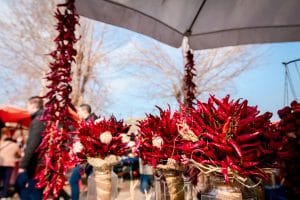
Paprika: (Seasoning) This is perhaps the defining spice in Serbian cuisine. Paprika actually originated in the Americas and entered Serbia through Hungarian and Ottoman influences. Serbian paprika, particularly from Vojvodina, is known for its rich, smoky-sweet profile, and pairs wonderfully with meats.
Pasulj: (Soup) A traditional bean soup, slow-cooked with spices and smoked meats, often eaten during winter.
Pekmez: (Spread) A thick fruit preserve, made by slowly cooking plums, apricots, or quinces without added sugar.
Pečenje: (Main) A whole lamb or pig is slow-roasted over a spit or in a wood-fired oven. This dish is a staple of major festivities like weddings, Orthodox Christmas and Easter, and village fairs. It is typically seasoned only with salt or garlic, and served with fresh bread, spring onions, and seasonal salads. The crackling outer skin is especially prized.
Pihtije: (Side dish) A savory meat aspic made by slow-cooking pork (particularly trotters, ears, and hocks) until the natural gelatin is released. Any meat is shredded from the animal parts used and, flavored with bay leaves and garlic, the gelatin is poured over the top and allowed to cool until firm. Typically served cold as an appetizer, pihtije is often accompanied by pickles, onions, and/or bread.
Pita sa višnjama: (Dessert) A sweet cherry-filled filo pastry, dusted with powdered sugar and enjoyed as a light dessert.
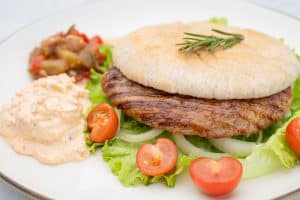
Pljeskavica: (Main Dish) A seasoned ground beef patty, grilled and served with onions and kajmak. Sometimes served on flatbread like a burger, either open-faced or wrapped in lepnija bread.
Plums: (Ingredient) Known as šljive in Serbia, plums are native to the land and feature heavily in Serbian food culture. Serbia is the world’s third largest producer of plums, and the fruit is used in a variety of ways, from fresh consumption to dried and preserved forms. The most famous plum-based product is rakija šljivovica, a traditional Serbian plum brandy. Plums are also used in making jams, compotes, and desserts such as šljivopita (plum pie) and knedle sa šljivama.
Podvarak: (Main Dish) A slow-baked dish of sauerkraut and roasted meat, flavored with garlic and paprika.
Popara: (Porridge) Made by soaking stale bread in hot milk, water, or tea, then mixing it with butter, cheese, or kajmak for a soft, porridge-like consistency. Popara is a nostalgic dish in Serbian households, especially in rural areas.
Prebranac: (Side dish) Baked beans seasoned with caramelized onions and paprika, often served during fasting periods in the Orthodox calendar.
Proja: (Bread) Made from cornmeal, water or milk, eggs, and oil, this bread is dense and slightly crumbly. Traditionally, it was a staple of rural households. Modern versions may include cheese, yogurt, or bacon for extra flavor. It is typically baked in a rectangular dish and cut into squares, served as a side to soups, stews, or grilled meats.
Pogača: (Bread) Slightly denser than lepinja, with a soft, fluffy interior and a golden crust. For Easter, this bread is made in an extra buttery, pull-apart formation.
Pršuta: (Appetizer) Serbian dry-cured ham, aged for months in mountain air, similar to Italian prosciutto.
Punjena paprika: (Main Dish) Bell peppers stuffed with a mixture of ground meat, rice, and spices, then simmered in a tomato-based sauce.

Rakija: (Spirit) A strong fruit brandy, often homemade, distilled from plums, apricots, or grapes, and served at celebrations. Each type is often known by an individual name. For instance, slivovitz, made from plums is perhaps most common. This can be served straight or prepared as a warm drink with added sugar or caramel in what is sometimes affectionately called “Serbian tea.”
Riblja čorba: (Soup) A rich, paprika-spiced fish soup typically made with freshwater fish, particularly popular along the Danube River.
Sač: (Food Preparation) A sač is a bell-shaped metal or clay dome used for slow-roasting food. Ingredients are placed in a shallow pan, covered with the sač lid, and buried under hot coals to cook slowly. The bell helps retain and circulate the air to promote even cooking. This technique results in tender, flavorful dishes with a crispy, caramelized crust and is central to preparing many Serbian dishes.
Sarma: (Main Dish) A beloved Serbian dish consisting of cabbage rolls stuffed with a savory mixture of minced, often smoked meats, rice, and spices. The rolls are slowly cooked allowing the flavors to meld into a rich, tangy dish. Sarma is especially popular during winter and is a staple at festive gatherings and celebrations.
Slatko: (Dessert) A thick fruit preserve, often made with whole cherries or strawberries, traditionally served to guests with water.
Slavski kolač: (Bread) This richly symbolic ritual bread baked for Slava, the Serbian Orthodox family saint day celebration that can last for multiple days. This is a rich bread heavy on eggs, milk, and butter. Sometimes dried fruit or nuts are added. It is often brought to a priest to be blessed before consumption. It is sometimes eaten with a little red wine poured over it.
Sremska kobasica: (Appetizer) A traditional smoked sausage from the Srem region, seasoned with paprika and garlic. Often enjoyed as part of a cold platter or grilled.
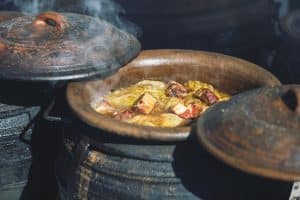
Svadbarski kupus: (Main Dish) “Wedding cabbage,” a celebratory dish of layered cabbage and meat slow-cooked for large gatherings. The meat is usually pork and several cuts (including trotters, etc.) are included. The full thing is cooked in a traditional clay pot.
Šljivovica: (Spirit) A potent plum brandy, considered a Serbian national drink, often used for toasts and celebrations.
Teleća čorba: (Soup) A hearty veal soup with vegetables such as carrots, potatoes, onions, and celery. Sometimes dumplings are added as well. It is thickened with flour, cream, or egg yolks to give it a creamy texture and often seasoned with bay leaves, black pepper, and parsley. Often prepared for Sunday family meals.
Tufahije: (Dessert) Poached apples stuffed with walnuts and sugar, then drizzled with syrup or honey and sometimes topped with whipped cream.
Urnebes: (Condiment) Often referred to as a “salad” this dish consists mostly of cream cheese, paprika, and garlic and is meant to be eaten after being spread on grilled meats and/or fresh bread.
Vanilice: (Dessert) Small, soft sandwich cookies filled with jam and dusted with powdered sugar, a staple of Serbian holidays.
Vegeta: (Seasoning) A versatile seasoning blend of dried vegetables, salt, and spices, widely used in Serbian cooking to enhance soups, stews, and rice dishes.
Vešalica: (Main Dish) Grilled pork loin, marinated and traditionally cooked over open flame, a staple of Serbian barbecue. The city of Leskovac in Serbia’s south is credited with the origin of this meat dish.
Vlaški doručak: (Porridge) “Vlach breakfast,” consisting of polenta topped with crumbled cheese and pork cracklings, especially popular in eastern Serbia. “Vlaški” refers to the native inhabitants of a small peninsula in Croatia.
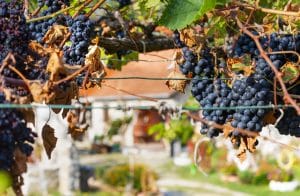
Vranac: (Beverage) A full-bodied red wine native to Serbia. Known for its deep, rich flavor, it pairs well with Serbia’s many meat dishes.
Walnuts: (Ingredient) A staple in Serbian cuisine for centuries, walnuts grow abundantly in the region’s temperate climate. They are commonly used in desserts like orasnice (walnut cookies) and baklava, showcasing both local and Ottoman influences. Their rich, earthy flavor and slight bitterness add depth to Serbian sweets, balancing out honey and sugar.
Zeljanica: (Breads) A spinach and cheese filo pie, similar to gibanica but featuring greens as the main ingredient.
Zlatiborska čajna: (Appetizer) A dry-cured sausage from the Zlatibor region, made from finely ground pork and beef, seasoned with garlic and spices. Often enjoyed sliced with cheese and bread.
Zlatiborski sir: (Dairy product) A semi-hard cow’s milk cheese from the Zlatibor mountain region, often aged in sheepskin. Known for its creamy texture and rich, slightly tangy flavor, it can be fresh and soft like mladi sir or aged for a firmer consistency. This cheese is often enjoyed with bread, kajmak, or smoked meats.
Žito sa šlagom: (Dessert) A sweet wheat pudding topped with whipped cream, often served at religious celebrations (like slava) and family gatherings.
You’ll Also Love
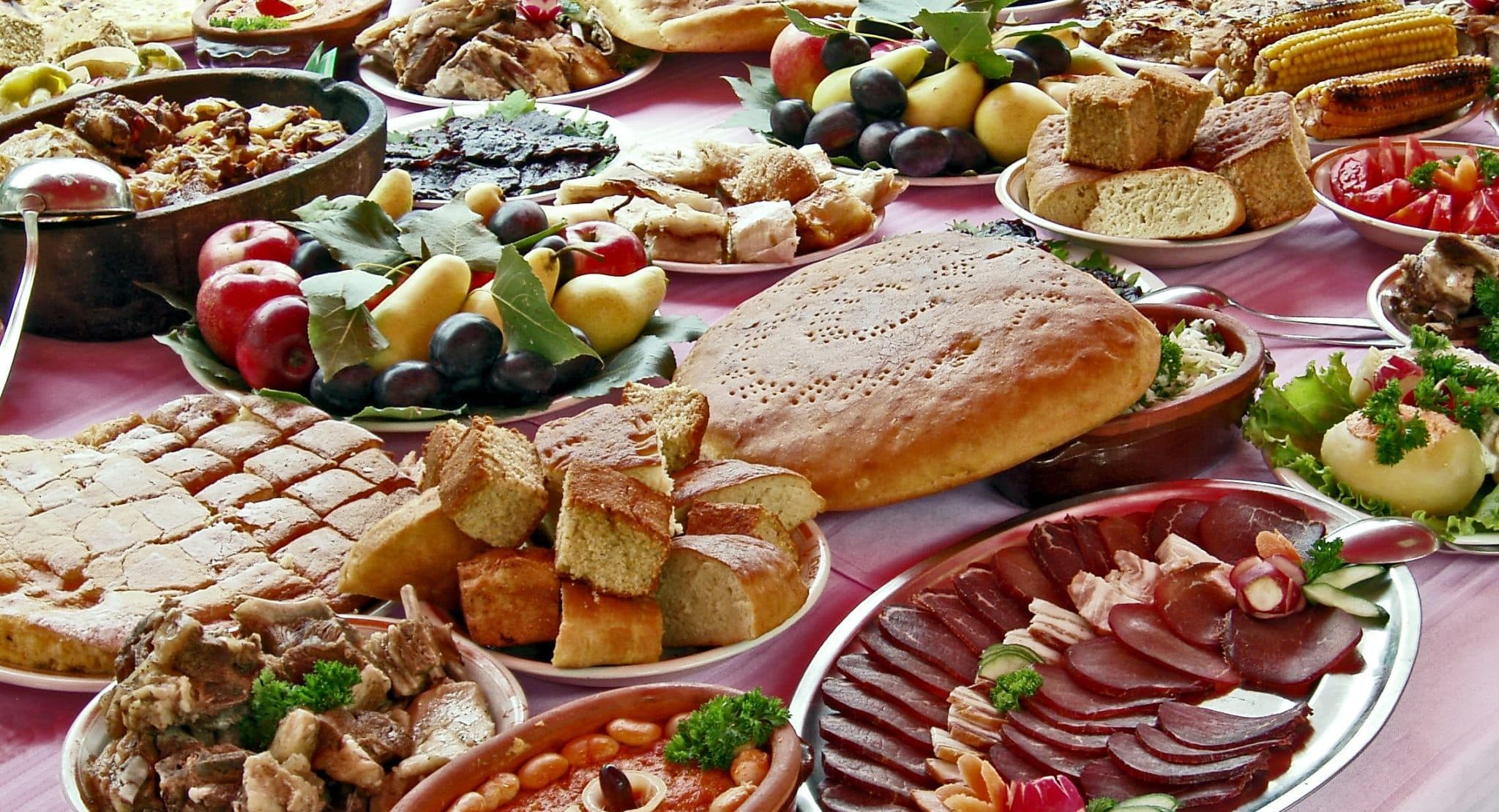
The Serbian Food Dictionary
Serbian cuisine is heavy on meat, dairy, and grains, a product of the nation’s geography and history. Serbia’s mountainous south lends itself to pastoralism and the earliest Serbs were mostly herdsmen. The Ottomans, who dominated Serbia from the 14th-19th centuries, were more interested in Serbia’s fertile river valleys, concentrated in the north. Serbs and their […]

The Talking Serbian Phrasebook
The Talking Phrasebook Series presents useful phrases and words in side-by-side translation and with audio files specifically geared to help students work on listening skills and pronunciation. Below, you will find several useful phrases and words. To the left is the English and to the far right is the Serbian translation in both Latin and […]
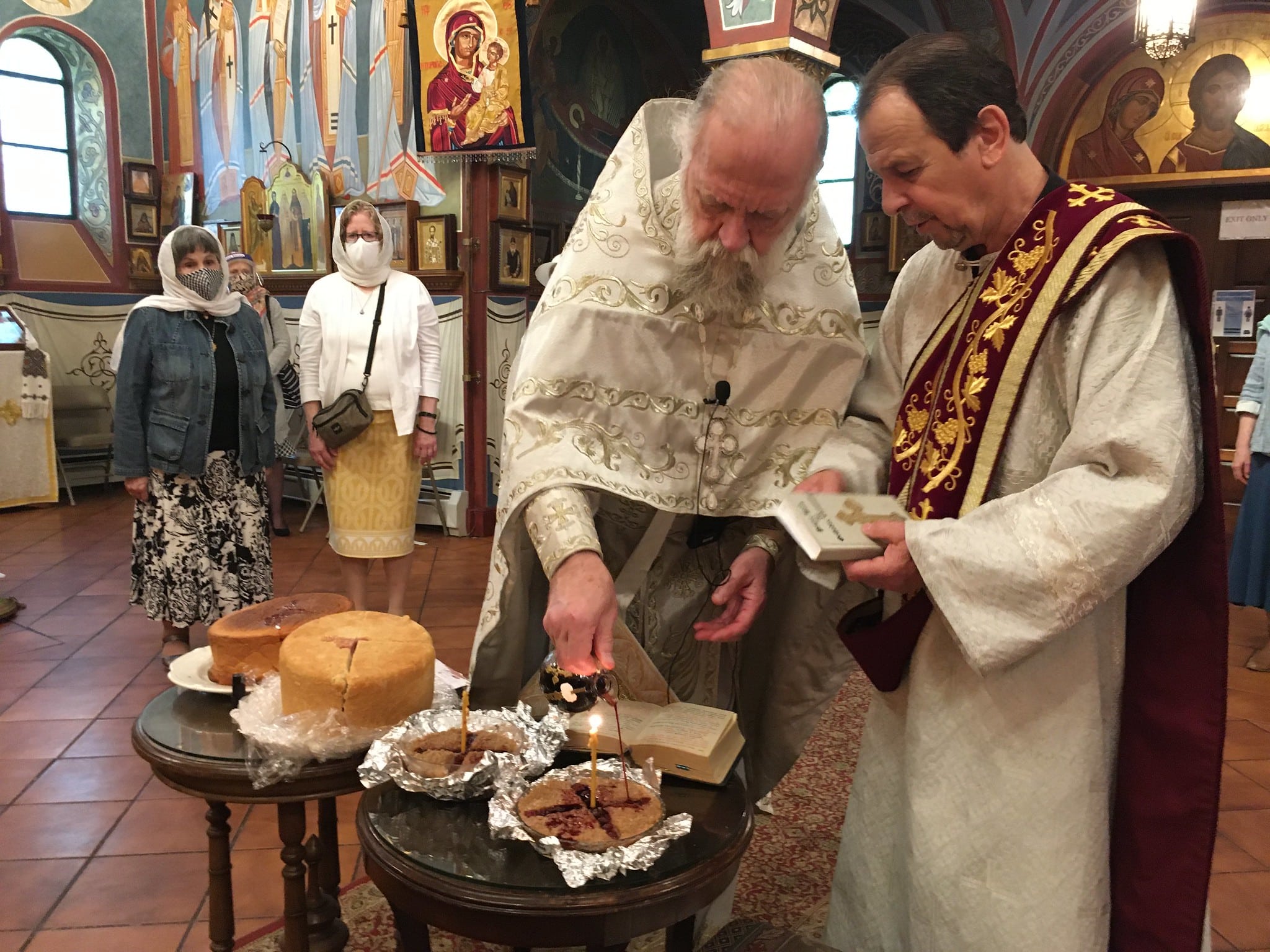
Serbian Holidays 2026: A Complete Guide
Serbian holidays show how civic and religious identity are often interchangeable in Serbia. Religion enters into almost every holiday listed below. Many of these holidays focus on family and tradition, but many observances focus on the sacrifices that Serbs have made in wars and battles ranging from the Battle of Kosovo in 1389 to WWI […]

Serbia’s Story of Identity: Heroes, Memory, and Meaning
What shapes Sebian national identity? The answer is complex and personal, but one key element is the Sebian national narrative. This includes the heroes and pivotal events taught in schools, the places central to the nation’s collective memory, and the language and beliefs that frame its worldview. A national narrative goes beyond history: it is […]




